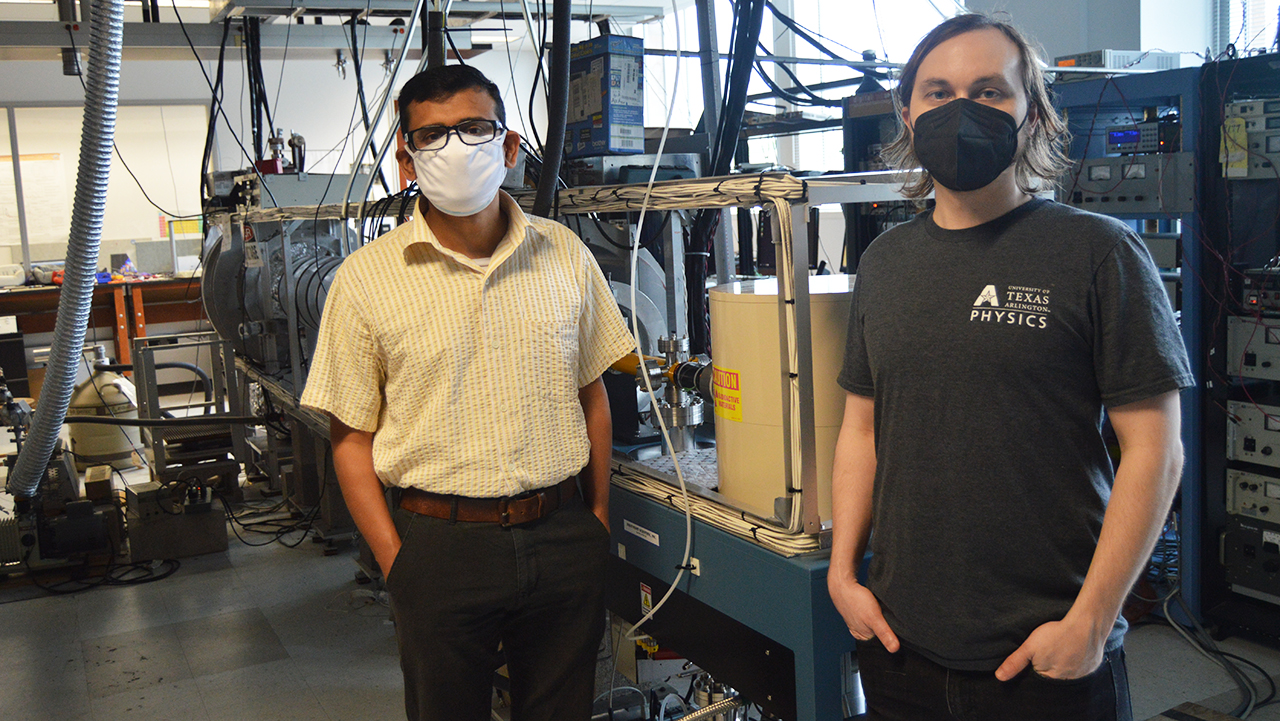Physicists at The University of Texas at Arlington have developed a new technique that can measure the properties of the topmost atomic layer of materials without including information from the underlying layers.
 Varghese Chirayath, UTA assistant professor of research, left, and Alex Fairchild, postdoctoral scholar. Image Credit: The University of Texas at Arlington
Varghese Chirayath, UTA assistant professor of research, left, and Alex Fairchild, postdoctoral scholar. Image Credit: The University of Texas at Arlington
Researchers from the Positron Lab in the UTA Department of Physics utilized a process called Auger-Mediated Positron Sticking (AMPS) to develop a novel spectroscopic tool to measure the electronic structure of the surface of materials selectively.
A new article, titled "Photoemission spectroscopy using virtual photons emitted by positron sticking: A complementary probe for top-layer surface electronic structures," published in the August 29 edition of the journal Physical Review Letters, discusses the details of the new surface selective spectroscopic technique.
In addition, the online magazine Physics published a Viewpoint article on the publication, titled “Spectroscopy That Doesn’t Scratch the Surface”, which explains why the paper is important to the field. Viewpoint articles are commissioned by PRL editors for papers which they believe will draw broad interest.
Alex Fairchild, postdoctoral scholar in the Positron Lab, is the study's lead author. Co-authors include Varghese Chirayath, assistant professor of research; Randall Gladen, postdoctoral researcher; Ali Koymen, professor of physics; and Alex Weiss, professor and chair of the UTA Department of Physics. Bernardo Barbiellini, professor of physics at LUT University in Finland, also contributed to the project.
The AMPS process, where positrons (antimatter of electrons) stick directly to surfaces followed by electron emission, was first observed and described by Saurabh Mukherjee, a graduate student, along with Weiss and other colleagues, in 2010 at UTA. Those results were published in a paper in Physical Review Letters.
"Alex and Varghese figured out how to use this phenomenon that we discovered in 2010 to measure the top layer and get information about the electronic structure and the behavior of the electrons in the top layer," Weiss said. "That will determine a material's many properties including conductivity and can have important implications for building devices."
"What makes AMPS-based spectroscopic technique unique is that it utilizes virtual photons to selectively probe electronic states solely at the topmost atomic layer," Fairchild said. "This is different from typical techniques like photoemission spectroscopy (PES) where a (real) photon penetrates multiple layers into the bulk of a material and therefore contains the combined information of the surface and subsurface layers."
To measure the electronic structure of the topmost atomic layer, the UTA team used virtual photons emitted following the sticking of incident positrons on the solid surface instead of real photons.
"We conclusively proved the selective probing of the topmost atomic layer by using AMPS to measure the electronic structure of a single layer of carbon atoms — most popularly known as single-layer graphene — on a copper substrate," Chirayath said. "Our measurements showed that the AMPS photoelectrons originated entirely from the single layer graphene without any contribution from copper. The AMPS data looked completely different as soon as we removed graphene as we were now measuring the electronic structure of the copper surface."
The new technique is distinguished from existing methods because no real particle penetrates the sample, the team explained in the article. These virtual photons can excite electronic transitions like real photons; however, they are screened rapidly, penetrating less than 0.1 nanometers. Thus, the new technique provides a very delicate way of probing the surface electronic structure of only the topmost atomic layer of 2D and fragile materials.
"Our AMPS results showed how virtual photons emitted following positron-sticking interact preferably with electrons that extend further into the vacuum than with electrons that were more localized to the atomic site," Chirayath said. "Our results are thus essential to understand how positrons interact with surface electrons and are extremely important to understand other similarly surface selective positron-based techniques."
"Our research not only invented a new technique but also developed the required theoretical model that showed how the AMPS spectrum reflects the surface electronic structure as sampled by the positron which got stuck on the surface," Chirayath pointed out.
Weiss noted that the UTA Positron Lab is currently the only place this technique could have been developed due to the intricate capabilities of the lab's positron beam.
"At present, UTA probably has the only lab in the world that has a positron beam that can get down to the low energies needed to observe this phenomenon," Weiss said. "The beam we have is unique in being able to get down to these low energies."
The study was supported by funding from the Welch Foundation and the National Science Foundation.